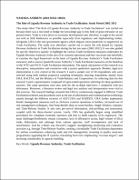| dc.description.abstract | NAMARA ANDREW (2010-M162-10010)
The Role of Uganda Revenue Authority in Trade Facilitation: Study Period 2002-2012
This study titled “The Role of Uganda Revenue Authority in Trade Facilitation” was carried out because there was a real need to bridge the knowledge gap in this field of great relevance in our present times. Trade is a key driver to economic development and, therefore, it ought to be carried out with as little hindrances as possible especially from regulatory and implementing bodies. InUganda, URA is the sole government agency which impacts most (positively or negatively) on Trade Facilitation. The study was, therefore, carried out to assess the role played by Uganda Revenue Authority in Trade Facilitation during the last ten years (2002-2012). It was also guided by specific objectives namely: to highlight the various Trade Facilitation measures undertaken by Uganda Revenue Authority in the area of its customs operations and their successes and shortfalls; to examine the legal framework on the basis of Uganda Revenue Authority‟s Trade Facilitation measures; and to assess Uganda Revenue Authority‟s Trade Facilitation measures on the backdrop of the WTO and WCO Trade Facilitation instruments. The nature and pattern of this research was descriptive, interpretative and evaluative with a purely qualitative approach. Besides, legal text interpretation is very central in this research. I used a sample size of 50 respondents who were selected using both random purposive sampling techniques, drawing respondents mainly from URA, KACITA, and the Ministry of Trade/Industry and Cooperatives. In collecting data for this research I used a questionnaire composed of open-ended questions soliciting for deep qualitative answers. The same questions were also used for the in-depth interviews I conducted with key informants. Moreover, a literature review and legal text analysis and interpretation were vital to this exercise. The research findings revealed that URA is continuously engaged in different Trade Facilitation schemes and procedures such as the use of information and communication technology mainly through the different versions of ASYCUDA and RADDEX. URA further implements border management measures such as 24-hours customs operations at borders, increased use of risk management techniques, One-Stop-Border shop on some borders, Single Window concepts, and Time-Release Studies. It also uses pre-arrival information, risk-profiling and assessment, coupled with the three-channel system. Lastly, URA has gradually begun using simplified procedures for compliant economic operators and tries to build capacity of its employees. The main challenges/bottlenecks remain corruption, lack of affirmative action, high volume of illicit trade, disharmony and sabotage from various agencies, staff incompetence and lack of sensitisation. And for a better way forward I suggest: strengthening monitoring and evaluation activities e.g. through Time-Release Studies; creating a formidable Trade Facilitation department for serious coordination; enhancing audit and risk management; investing in quality assurance programmes; upgrading the IT systems; restraining from over-emphasising “revenue targets”; and investing considerably in capacity building.
Key Words: Uganda Revenue Authority, Trade Facilitation. | en_US |


